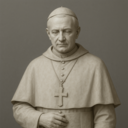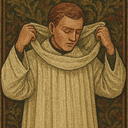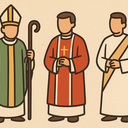Receive God's Love, Proclaim the Greatness of the Lord, Serve Joyfully & Make Missionary Disciples of Jesus Christ
Search
News - Home RSS Feed
-
This year All Saints’ Day is NOT a Holy Day of Obligation. All Saints’ Day is an important feast in the Catholic Church. All Saints’ Day is dedicated to the saints of the Church, that is all those who have attained heaven. Masses Friday, October 31 7:00 pm Spanish Saturday, November 1 8:15 am EnglishRead More
-
 This Sunday we will not celebrate the 31st Sunday in Ordinary Time at Mass. Because it falls on November 2, we will instead observe the Commemoration of All the Faithful Departed—more commonly known as All Souls Day. All Souls Day is a time to pray especially for those who have died but are not canonized saints. It gives us the opportunity to remember and intercede for the souls in purgatory, a practice that has been part of the Church’s liturgy for over a thousand years. The custom began in monastic communities and was later adopted in Rome in the 13th century as a universal observance on November 2. READ MORERead More
This Sunday we will not celebrate the 31st Sunday in Ordinary Time at Mass. Because it falls on November 2, we will instead observe the Commemoration of All the Faithful Departed—more commonly known as All Souls Day. All Souls Day is a time to pray especially for those who have died but are not canonized saints. It gives us the opportunity to remember and intercede for the souls in purgatory, a practice that has been part of the Church’s liturgy for over a thousand years. The custom began in monastic communities and was later adopted in Rome in the 13th century as a universal observance on November 2. READ MORERead More -
 Mary Queen of the Holy Rosary Parish is seeking a detail-oriented, organized, and trustworthy Bookkeeper to join our office team. The ideal candidate will support the financial operations of the parish and school, maintain accurate records and ensure compliance with diocesan financial procedures. Email your resume to [email protected] SEE FULL JOB DESCRIPTION HERERead More
Mary Queen of the Holy Rosary Parish is seeking a detail-oriented, organized, and trustworthy Bookkeeper to join our office team. The ideal candidate will support the financial operations of the parish and school, maintain accurate records and ensure compliance with diocesan financial procedures. Email your resume to [email protected] SEE FULL JOB DESCRIPTION HERERead More -
 You may have noticed a new feature during Mass this month — we have been singing the Latin Salve Regina at the conclusion of Communion. A natural question might be: why? October is traditionally known as the Month of the Rosary, and the Salve Regina (Hail, Holy Queen) is one of the concluding prayers of the Rosary. In addition, the Church holds a small but meaningful tradition of adding Marian antiphons to the end of liturgies, especially within the Divine Office. The Salve Regina—assigned to this season—is one of four Marian antiphons that change throughout the liturgical year. READ MORERead More
You may have noticed a new feature during Mass this month — we have been singing the Latin Salve Regina at the conclusion of Communion. A natural question might be: why? October is traditionally known as the Month of the Rosary, and the Salve Regina (Hail, Holy Queen) is one of the concluding prayers of the Rosary. In addition, the Church holds a small but meaningful tradition of adding Marian antiphons to the end of liturgies, especially within the Divine Office. The Salve Regina—assigned to this season—is one of four Marian antiphons that change throughout the liturgical year. READ MORERead More -
 Our 2025 #iGiveCatholic goal is to raise $25,000 to be applied towards our ELC mortgage interest payments, assisting to help eliminate this debt. Once eliminated, imagine the freedom we’ll have as those funds are redirected to strengthen the Catholic education and parish life here at Mary Queen. By helping us reduce this debt, you are directly investing in the future of our children, families, and the community we serve. Every gift—large or small—moves us closer to a debt-free future and ensures that generations to come can thrive academically and spiritually. Together, we can lift this burden and open the doors to new opportunities. Advanced giving begins Monday, November 17, 2025, and Giving Tuesday is December 2, 2025. Donations may be made online, in person at Mass, or through the school. From the bottom of our hearts, we thank you for your continued generosity and faith in our mission. We could not do this without you. With Gratitude and Blessings, Mary Queen of the Holy Rosary Parish and SchoolRead More
Our 2025 #iGiveCatholic goal is to raise $25,000 to be applied towards our ELC mortgage interest payments, assisting to help eliminate this debt. Once eliminated, imagine the freedom we’ll have as those funds are redirected to strengthen the Catholic education and parish life here at Mary Queen. By helping us reduce this debt, you are directly investing in the future of our children, families, and the community we serve. Every gift—large or small—moves us closer to a debt-free future and ensures that generations to come can thrive academically and spiritually. Together, we can lift this burden and open the doors to new opportunities. Advanced giving begins Monday, November 17, 2025, and Giving Tuesday is December 2, 2025. Donations may be made online, in person at Mass, or through the school. From the bottom of our hearts, we thank you for your continued generosity and faith in our mission. We could not do this without you. With Gratitude and Blessings, Mary Queen of the Holy Rosary Parish and SchoolRead More -
 The vesture of the Holy Father, the Bishop of Rome, carries profound symbolism that reflects his unique role as the successor of Saint Peter and the visible head of the universal Church. While rooted in the same liturgical tradition shared by all bishops, papal garments have developed distinct forms and colors that express the Pope’s pastoral mission, humility, and spiritual authority. READ MORERead More
The vesture of the Holy Father, the Bishop of Rome, carries profound symbolism that reflects his unique role as the successor of Saint Peter and the visible head of the universal Church. While rooted in the same liturgical tradition shared by all bishops, papal garments have developed distinct forms and colors that express the Pope’s pastoral mission, humility, and spiritual authority. READ MORERead More -
 "He has shown you, O mortal, what is good. And what does the Lord require of you? To act justly and to love mercy and to walk humbly with your God". Micah 6:8 BUILD has a 4 season process and we are now in the 1st stage - the Listening Process. So far at MQ we have had 5 house meetings and listened to the cares and concerns of 40 people. READ MORERead More
"He has shown you, O mortal, what is good. And what does the Lord require of you? To act justly and to love mercy and to walk humbly with your God". Micah 6:8 BUILD has a 4 season process and we are now in the 1st stage - the Listening Process. So far at MQ we have had 5 house meetings and listened to the cares and concerns of 40 people. READ MORERead More -
 As principal advisors to the Holy Father and senior members of the Church’s hierarchy, Cardinals wear attire that reflects both their unity with the Pope and their readiness to serve the universal Church. Their garments, rich in history and symbolism, express not privilege, but deeper dedication to Christ and His mission. READ MORERead More
As principal advisors to the Holy Father and senior members of the Church’s hierarchy, Cardinals wear attire that reflects both their unity with the Pope and their readiness to serve the universal Church. Their garments, rich in history and symbolism, express not privilege, but deeper dedication to Christ and His mission. READ MORERead More -
 As a bishop serves the Church, his attire extends beyond the liturgical vestments of the Mass. Distinctive garments and insignia mark his office in public settings, in daily prayer, and in his pastoral ministry. Each carries a history and symbolism that recalls his consecration as shepherd of God’s people. READ MORERead More
As a bishop serves the Church, his attire extends beyond the liturgical vestments of the Mass. Distinctive garments and insignia mark his office in public settings, in daily prayer, and in his pastoral ministry. Each carries a history and symbolism that recalls his consecration as shepherd of God’s people. READ MORERead More -
 On October 1, 1995, at 3 p.m., our current church was dedicated by Bishop Kendrick Williams. It was a joyful day that began with a final Mass in the old church and culminated in the dedication of our new space. The liturgy included the blessing of the church, altar, and tabernacle, marked with candles, music, oil, flame, and solemn ritual. This powerful celebration remains central to our parish, as our church was set apart to inc . This anniversary also serves as the kickoff to our novena leading to our parish feast, October 7—the Memorial of Our Lady of the Rosary. READ MORERead More
On October 1, 1995, at 3 p.m., our current church was dedicated by Bishop Kendrick Williams. It was a joyful day that began with a final Mass in the old church and culminated in the dedication of our new space. The liturgy included the blessing of the church, altar, and tabernacle, marked with candles, music, oil, flame, and solemn ritual. This powerful celebration remains central to our parish, as our church was set apart to inc . This anniversary also serves as the kickoff to our novena leading to our parish feast, October 7—the Memorial of Our Lady of the Rosary. READ MORERead More -
 As clergy prepare for Mass, the vesting process is accompanied by solemn actions and prayers. These sacred moments help the bishop prepare himself to serve as shepherd of the Church. The bishop—through baptism, ordination, and episcopal consecration—is set apart as a successor to the Apostles, charged with teaching, sanctifying, and governing the People of God. READ MORERead More
As clergy prepare for Mass, the vesting process is accompanied by solemn actions and prayers. These sacred moments help the bishop prepare himself to serve as shepherd of the Church. The bishop—through baptism, ordination, and episcopal consecration—is set apart as a successor to the Apostles, charged with teaching, sanctifying, and governing the People of God. READ MORERead More - Read More
-
 As clergy prepare for Mass, the vesting process is accompanied by solemn actions and prayers. These sacred moments help the deacon prepare himself to serve at the altar of Christ. The deacon—through baptism and ordination—is set apart for the ministry of service in Word, altar, and charity. The deacon first dons the alb, that long white garment common to all ordained ministers and altar servers. It recalls the baptismal garment, symbolizing purity and new life in Christ. Secured by the cincture, it prepares the deacon for humble service and reminds him of the call to chastity and self-discipline. READ MORERead More
As clergy prepare for Mass, the vesting process is accompanied by solemn actions and prayers. These sacred moments help the deacon prepare himself to serve at the altar of Christ. The deacon—through baptism and ordination—is set apart for the ministry of service in Word, altar, and charity. The deacon first dons the alb, that long white garment common to all ordained ministers and altar servers. It recalls the baptismal garment, symbolizing purity and new life in Christ. Secured by the cincture, it prepares the deacon for humble service and reminds him of the call to chastity and self-discipline. READ MORERead More -
 As clergy prepare for Mass, the vesting process is accompanied by solemn actions and prayers. These sacred moments help the priest ready himself to act in persona Christi. The word holy refers to what is set apart for sacred use; in this sense, the priest himself is holy—through baptism and ordination—set apart for the sacraments. READ MORERead More
As clergy prepare for Mass, the vesting process is accompanied by solemn actions and prayers. These sacred moments help the priest ready himself to act in persona Christi. The word holy refers to what is set apart for sacred use; in this sense, the priest himself is holy—through baptism and ordination—set apart for the sacraments. READ MORERead More -

-
 As the clergy prepare for Mass, there are solemn actions and prayers that accompany the vesting process. These sacred moments are intended to help the priest prepare to act In Persona Christi. The word holy refers to things set apart for sacred use. In this sense, the priest himself is holy—by virtue of his baptism and ordination—set apart for the sacred work of the sacraments. READ MORERead More
As the clergy prepare for Mass, there are solemn actions and prayers that accompany the vesting process. These sacred moments are intended to help the priest prepare to act In Persona Christi. The word holy refers to things set apart for sacred use. In this sense, the priest himself is holy—by virtue of his baptism and ordination—set apart for the sacred work of the sacraments. READ MORERead More -
 There are few places in modern culture where it is considered normal to wear a tunic undergarment, an additional robe, and a distinctive form of headwear. Such ceremonial attire is now reserved for religious, legal, and limited political settings. READ MORE...Read More
There are few places in modern culture where it is considered normal to wear a tunic undergarment, an additional robe, and a distinctive form of headwear. Such ceremonial attire is now reserved for religious, legal, and limited political settings. READ MORE...Read More -
 LITURGY CORNER Priestly Attire: The Collar It’s almost a given in our Catholic world: if you run into a priest outside of Mass, he’ll likely be wearing that distinctive white collar. Without it, how would you know who was clergy? Interestingly, this modern collar is a fairly recent invention. The removable style was created in 1865 by Rev. Donald McLeod, a Presbyterian minister. It quickly caught on among liturgically minded clergy and, by the mid-1880s, was a well-established and expected part of Roman Catholic clerical dress.Read More
LITURGY CORNER Priestly Attire: The Collar It’s almost a given in our Catholic world: if you run into a priest outside of Mass, he’ll likely be wearing that distinctive white collar. Without it, how would you know who was clergy? Interestingly, this modern collar is a fairly recent invention. The removable style was created in 1865 by Rev. Donald McLeod, a Presbyterian minister. It quickly caught on among liturgically minded clergy and, by the mid-1880s, was a well-established and expected part of Roman Catholic clerical dress.Read More -
CLICK HERE for the Mary Queen School Day traffic flow map.Read More
-
 Mary Queen of the Holy Rosary Parish in Lexington, KY, is seeking a passionate and dynamic Youth Ministry Assistant for approximately ten hours a week, to help lead our efforts in nurturing vibrant faith among young people on Wednesday nights. SEE THE JOB DESCRIPTION HERERead More
See More
Mary Queen of the Holy Rosary Parish in Lexington, KY, is seeking a passionate and dynamic Youth Ministry Assistant for approximately ten hours a week, to help lead our efforts in nurturing vibrant faith among young people on Wednesday nights. SEE THE JOB DESCRIPTION HERERead More
See More
